Living fences offer superior climate resilience compared to conventional barriers. They withstand extreme weather, create protective microclimates, and reduce temperatures through evapotranspiration. Their extensive root systems prevent erosion, absorb excess water during floods, and maintain moisture during droughts. You’ll benefit from year-round biodiversity support with sequential flowering patterns that attract beneficial wildlife. These natural barriers adapt to changing conditions through evolved defense mechanisms, ensuring your landscape remains protected as climate patterns become increasingly unpredictable.
Seasonal Resilience of Living Barriers Through Weather Extremes
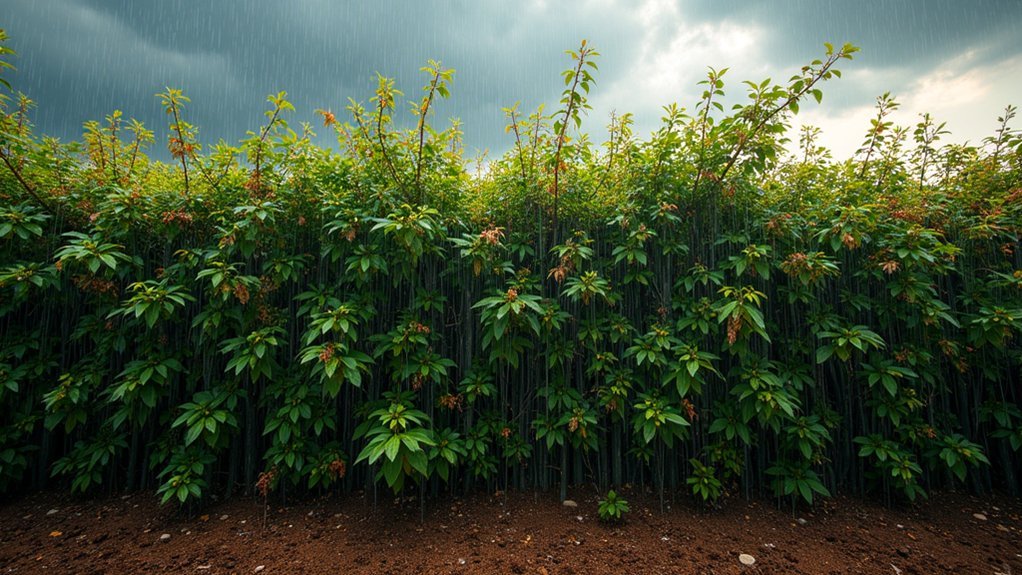
While conventional fencing systems often falter under extreme weather conditions, living fences demonstrate remarkable resilience throughout seasonal changes.
Living fences thrive through nature’s harshest tests while traditional barriers crumble against the elements.
Their diverse composition of species like elder, mulberry, and honey locust provides protein-rich forage for livestock year-round.
Living fences also create stunning aesthetic value to landscapes while serving practical functions, transforming property boundaries into beautiful natural features.
You’ll find these living barriers create protective microclimates by blocking harsh winds—a six-foot hedge can shield areas up to 100 yards downwind.
Their extensive root systems continuously strengthen soil structure, preventing erosion during heavy rains while maintaining moisture in drought.
Most impressively, many species can coppice, regenerating quickly after damage from storms or frost.
This self-renewal capacity guarantees your fence maintains its integrity without the replacement costs of manufactured alternatives, while simultaneously supporting biodiversity through seasonal extremes.
Winter Protection Strategies for Living Fence Systems
Unlike conventional barriers that remain static, living fence systems require specific protection strategies to thrive through harsh winter conditions.
You’ll need to establish protective measures during the first 3-5 years while plants develop their resilience.
Install wildlife guards around young stems and maintain a 150-200 ft setback from protected areas to prevent snowdrift encroachment.
Space shrubs 4-6 ft apart and trees 12-15 ft apart for ideal density and snow-capturing capability.
Once established, these living barriers deliver exceptional performance—capturing up to 12× more snow per foot than slatted alternatives while lasting 40-50 years with minimal maintenance.
Your investment in winter protection pays off through reduced energy costs, improved microclimate stability, and enhanced wildlife habitat that artificial barriers can’t match.
Summer Heat Adaptation in Natural Barrier Species
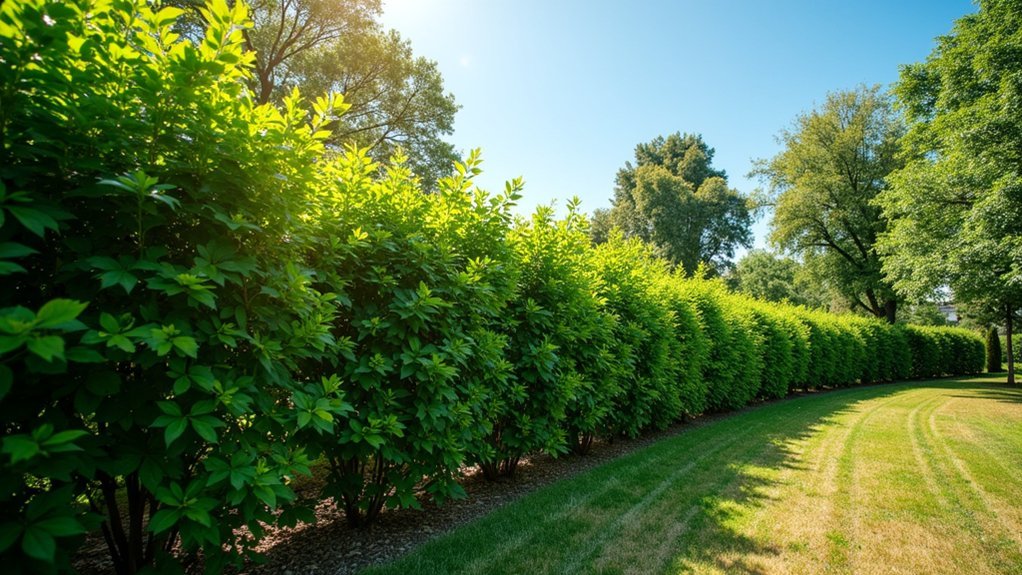
You’ll find that strategic living fence placement creates microclimate cooling networks, buffering vulnerable species against intensifying summer heat.
These natural barriers leverage phenotypic plasticity and genetic diversity to establish drought-resistant shade zones that protect soil moisture and support biodiversity during extreme temperatures. Different plant species within these living barriers offer behavioral thermoregulation options for terrestrial organisms seeking refuge from excessive heat.
Microclimate Cooling Networks
As summer temperatures continue to rise due to climate change, living fences offer a strategic solution through their ability to create microclimate cooling networks.
You’ll benefit from their evaporation-cooling effect, where vegetation actively reduces ambient temperatures through transpiration.
By strategically placing these natural barriers around your property, you’re creating interconnected zones of moderated temperatures.
The dense foliage not only provides essential shade but also retains soil moisture that would otherwise be lost to hot winds. This thermal buffering effect can notably reduce cooling costs for nearby structures.
For maximum effectiveness, incorporate diverse plant species like thornless blackberry hedgerows or grape vines, and consider integrating water storage features nearby. Living fences contribute to biodiversity enhancement by providing habitat for beneficial insects and birds that support your farm’s ecosystem.
This combination creates resilient cooling networks that protect your space from extreme heat while supporting local biodiversity.
Drought-Resistant Shade Providers
While microclimate cooling networks offer broad temperature benefits, selecting the right shade-providing species forms the backbone of any effective living fence strategy.
For maximum summer heat adaptation, consider drought-tolerant trees with substantial canopies. Eastern Redcedar and Honeylocust excel in hot, dry conditions while providing dense shade. Bur Oak and Kentucky Coffeetree represent premier choices for heat-prone areas, offering impressive canopies that reduce soil temperature and moisture loss. Hackberry is particularly valuable for living fences due to its ability to tolerate strong winds and air pollution.
For smaller gardens, Judas Tree (Cercis siliquastrum) combines drought tolerance with beautiful pink spring flowers.
Remember that established old-growth trees withstand drought better than younger specimens. When planting your living fence, prioritize proper initial watering regimes and select species native to your region for enhanced climate resilience and long-term sustainability against intensifying heat waves.
Microclimate Creation Around Seasonal Living Fences
Living fences create powerful microclimates that greatly impact their surroundings, functioning as more than simple boundaries. They moderate temperatures by providing shade and cooling hot air through evapotranspiration, potentially lowering ambient temperatures by several degrees.
As natural windbreaks, they’ll protect your garden from drying winds, reducing moisture loss and preventing soil erosion. The dense foliage filters strong gusts while maintaining stable humidity levels in your growing areas.
Living fences tame harsh winds, conserving moisture and soil while creating stable, humid havens for your garden plants.
You’ll notice improved soil moisture retention near these fences as they shield the ground from direct sun and wind. Their seasonal adaptability is particularly valuable—providing cooling shade during summer months while allowing more sunlight penetration during cooler seasons. This natural solution contributes significantly to counteracting heat islands in urban environments.
This dynamic microclimate buffering extends growing seasons and creates resilient spaces where plants thrive despite climate variability.
Drought Response Mechanisms in Perennial Fence Plants
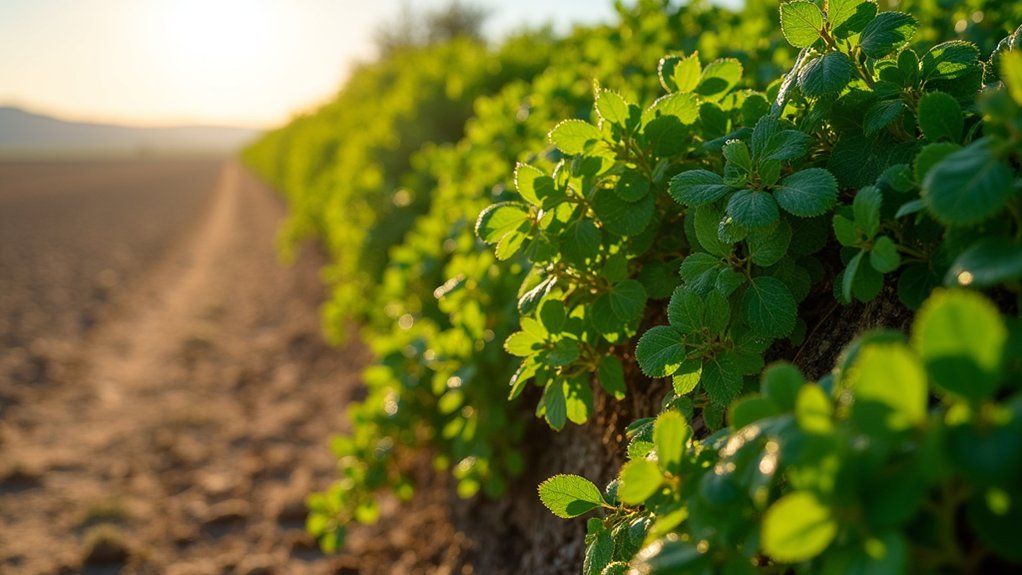
Perennial fence plants employ remarkable biological mechanisms that enable them to withstand extended dry periods, making them ideal choices for climate-resilient landscapes.
You’ll find these plants activate sophisticated defense systems when water becomes scarce.
- Avoidance strategies include developing deep root systems and smaller leaves to minimize water loss while maximizing uptake. During water limitation, these plants often exhibit significant changes in root biomass ratios, shifting energy to below-ground structures where water absorption capabilities are enhanced.
- Tolerance mechanisms maintain cellular integrity through osmoprotectants like sugars and proline that stabilize structures during stress.
- Hormonal responses trigger ABA-mediated stomatal closure, preventing excessive transpiration while balancing photosynthetic needs.
- Recovery capabilities allow these plants to quickly resume growth after drought ends, often through calcium signaling pathways that activate dormant systems.
These adaptations make perennial fence plants remarkably resilient against increasingly unpredictable rainfall patterns in our changing climate.
Flood Mitigation Benefits During High Precipitation Periods
When you establish living fences on your property, their extensive root systems create natural flood barriers by absorbing excess water and stabilizing soil during heavy rainfall.
You’ll notice a significant reduction in runoff as the vegetation slows water flow, allowing more time for absorption and preventing erosion downstream.
These natural flood control methods can protect your landscape more effectively than traditional fencing, especially in areas prone to seasonal flooding or increasing climate-related precipitation events.
In eastern Sonora, farmers have successfully used living fences to enhance floodplain farming and protect their fields from water damage during high precipitation periods.
Root System Influence
During heavy precipitation periods, the intricate network of roots beneath living fences plays an essential role in mitigating flood damage.
These powerful underground systems work tirelessly to protect your land from water-related destruction. Willow species are particularly effective in natural flood management strategies, creating leaky dams that naturally slow water flow during peak flooding events.
- Deep-penetrating roots stabilize slopes and riverbanks, preventing collapse when floodwaters rise and adding critical structural support to vulnerable areas.
- Enhanced water absorption reduces surface runoff by creating pathways for water to penetrate soil more effectively.
- Soil particle binding prevents erosion and preserves your valuable topsoil, maintaining land productivity even after heavy rains.
- Energy dissipation occurs as roots and vegetation absorb the force of fast-moving water, protecting your property and neighboring communities from the full impact of floods.
Runoff Control Methods
As high precipitation events become more frequent and intense with climate change, effective runoff control methods integrated with living fences can dramatically strengthen your property’s flood resilience.
Unlike traditional sediment fences with their six-month lifespan and limited drainage capacity, living fences provide lasting protection through their dense vegetation that absorbs excess water.
You’ll benefit from their root systems stabilizing soil while stems slow water movement across your landscape.
Combine your living fence with strategic grading techniques—slope land away from sensitive areas and use berms to direct water across gradual slopes to enhance infiltration.
For areas where natural absorption is limited, direct runoff toward vegetated zones that filter sediments while allowing water to infiltrate. Consider implementing geotextile silt fences along steeper slopes as a supplementary measure for maximum sediment control during heavy rain events.
This integrated approach offers both flood protection and ecosystem benefits traditional barriers can’t match.
Species Selection for Year-Round Climate Functionality
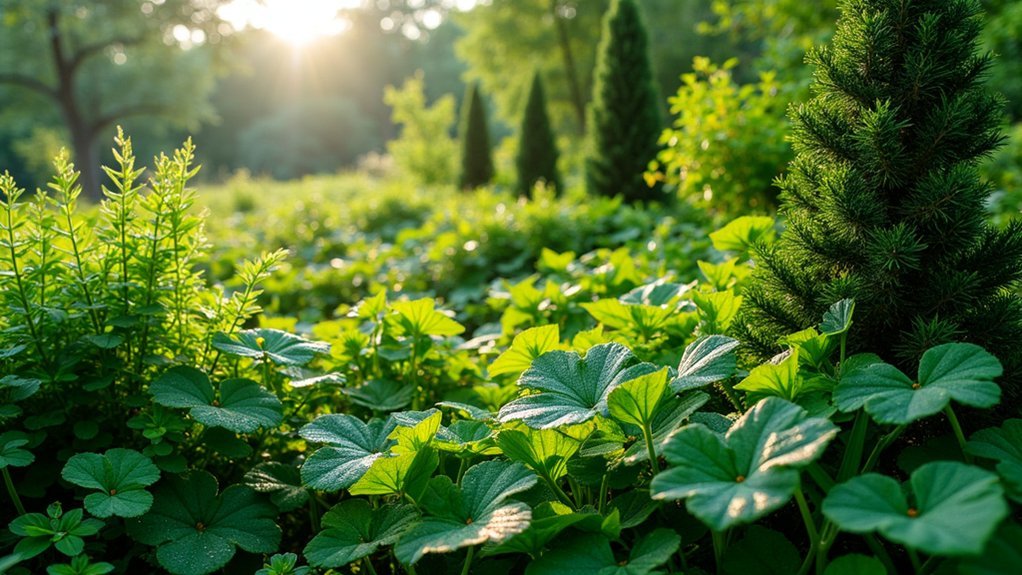
The success of living fences as climate-resilient structures largely depends on thoughtful species selection that functions effectively across all seasons.
You’ll want to create a balanced ecosystem that provides continuous benefits regardless of weather patterns.
- Mix evergreen and deciduous species to maintain shelter year-round while supporting seasonal nutrient cycling when leaves drop.
- Combine fast-growing pioneers (for quick establishment) with long-lived species (for structural stability and carbon storage).
- Include drought-tolerant and flood-resistant plants to withstand climate extremes without compromising fence integrity.
- Select multi-functional native species that attract wildlife, fix nitrogen, and create beneficial microclimates across seasons. Including a variety of native flowering shrubs like viburnums, blueberries, and elderberries ensures your fence provides food sources throughout different seasons.
This diversity approach guarantees your living fence remains functional and resilient through changing climatic conditions, providing continuous ecological services while protecting your property.
Seasonal Maintenance Cycles for Optimal Fence Performance
Your living fence requires different care throughout the year to maintain its structural integrity and ecological benefits.
You’ll need to adjust your pruning approach seasonally—structural cuts in spring for airflow, selective trimming in summer for stability, and dormant pruning in fall to shape future growth patterns.
Your soil amendment calendar should follow natural cycles: apply organic compost in spring after winter depletion, renew mulch layers during summer heat, and add insulating materials in fall before frost conditions set in.
During winter months, regular inspections help identify vulnerabilities while freeze-thaw cycles can create structural weaknesses that require attention before spring growth begins.
SUBHEADING DISCUSSION POINTS
Maintaining living fences requires strategic seasonal interventions to guarantee their long-term resilience and effectiveness.
You’ll maximize your fence’s health by aligning care with natural growth cycles, creating a robust barrier that thrives year-round despite climate challenges.
- Spring revival: Apply slow-release organic fertilizers and introduce beneficial insects like ladybugs to control early aphids while establishing drip irrigation systems.
- Summer vigilance: Monitor for fungal diseases during humidity spikes, water 1-1.5 inches weekly during heatwaves, and provide temporary shade during extreme heat events. These maintenance practices help your living fence continue to effectively sequester carbon dioxide, contributing to climate change mitigation while serving as a boundary.
- Fall preparation: Clear fallen debris, top-dress with compost, and reduce watering frequency as growth slows.
- Winter protection: Apply horticultural oils for pest control, water deeply before ground freezes, and install burlap screens in extreme cold zones.
Seasonal Pruning Techniques
Mastering seasonal pruning transforms your living fence from a simple barrier into a resilient, climate-adaptive ecosystem. Each season demands specific approaches to maximize fence health and functionality.
In spring, focus on training branches and removing weak growth to stimulate robust development. Create sheltered areas for sensitive species when pruning to protect them from challenging microclimates.
Summer maintenance should happen after growth completion to control size and prevent unwanted shoots. Limit autumn pruning to avoid encouraging late-season growth that won’t harden before winter.
Winter’s dormancy period is ideal for major structural reshaping of young plants.
For evergreens, prune just before spring growth begins. Regular maintenance enables early pest detection while supporting biodiversity and carbon sequestration.
Keep essential tools handy—hand pruners for precision work, loppers for thicker branches, and hedge trimmers for uniform shaping.
This seasonal rhythm guarantees your living fence adapts to changing climate conditions.
Soil Amendment Timeline
Just as seasonal pruning shapes the canopy of your living fence, a well-planned soil amendment timeline nurtures its foundation.
Your living fence requires strategic soil maintenance throughout the year to remain resilient against climate challenges.
- Spring (April) – Apply nitrogen-rich fertilizers like blood meal and replenish 1-2″ of compost to fuel vigorous growth after winter dormancy.
- Summer (Establishment) – Water 2-3 times weekly via soaker hoses and monitor soil moisture daily, adjusting irrigation when the top inch feels dry. The additional moisture helps establish deep root systems that serve as natural windbreaks against soil drying and erosion.
- Fall (October-November) – Incorporate slow-release fertilizers and leaf litter around the base, then test pH and amend with lime or sulfur accordingly.
- Winter (Preparation) – guarantee proper drainage before frost sets in and remove diseased foliage to prevent pathogen carryover.
Carbon Sequestration Patterns Across Seasonal Changes
As Earth cycles through its seasons, the carbon sequestration capacity of living fences undergoes significant fluctuations that mirror broader ecological patterns. During wet seasons, living fences allocate more carbon to leaf and wood production, maximizing their sequestration potential. Research demonstrates that evergreen species outperform deciduous varieties in daily carbon sequestration per unit canopy area.
Conversely, dry periods can actually increase carbon accumulation by reducing heterotrophic respiration while maintaining productivity.
You’ll notice your living fence’s carbon storage capability shifts with freeze-thaw cycles as well. When soil thaws, semi-decomposed litter carbon becomes incorporated into the soil matrix.
Biodiversity Enhancement Throughout Annual Cycles
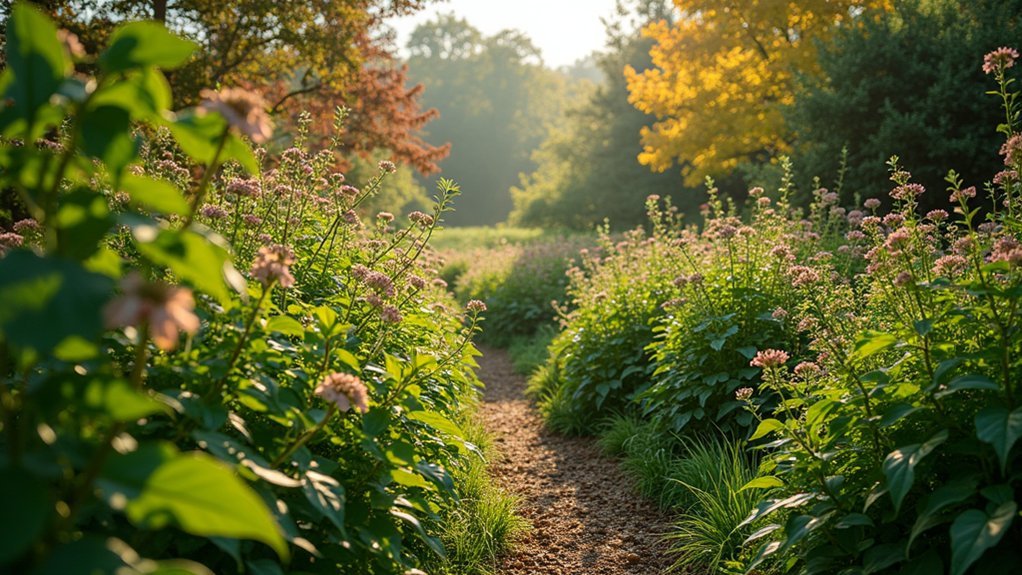
Living fences don’t just store carbon—they breathe life into ecosystems throughout the year.
These dynamic boundaries create continuous habitat when other landscape features may fail to support wildlife during seasonal changes.
Your living fence serves as a biodiversity hub through:
- Year-round shelter provision – offering nesting sites for birds, mammals, and overwintering spaces for beneficial insects
- Sequential flowering patterns – supporting pollinators from early spring (like Gelsemium sempervirens) through late autumn
- Seasonal microclimate modulation – creating shade in summer and allowing sunlight penetration in winter
- Food resource continuity – producing nectar, pollen, fruits, and seeds that sustain wildlife through different seasons
This seasonal diversity helps buffer local ecosystems against climate extremes while maintaining ecological functions throughout annual cycles.
Frequently Asked Questions
How Do Living Fences Affect Property Boundaries and Legal Considerations?
Living fences define property lines naturally but require legal agreements with neighbors. You’ll need to check local regulations, clarify maintenance responsibilities, and guarantee they don’t violate view or access rights.
Can Living Fences Connect With Existing Traditional Fencing Systems?
Yes, you can integrate living fences with traditional systems through modular replacements, complementary planting alongside existing structures, or creating hybrid barriers. Your living components will actually reinforce aging fences through stabilizing root networks.
What Are Typical Establishment Costs Compared to Conventional Fencing?
You’ll spend less upfront on living fences compared to conventional options. While they require regular maintenance, you’ll save long-term on replacement costs. They’re typically 20-30% cheaper to establish initially.
How Do Living Fences Impact Wildlife Migration Patterns?
Living fences allow wildlife to move naturally through their migration routes. You’ll see fewer detours, less genetic isolation, and reduced stress in animals. They’re encountering barriers 248 times less annually than with conventional fencing.
Will Living Fences Attract Unwanted Pests to My Property?
Living fences can attract some pests, but they’ll also bring beneficial predators that control them. With proper species selection, maintenance, and occasional pruning, you’ll create a balanced ecosystem that self-regulates pest populations naturally.
In Summary
By choosing living fences, you’re creating resilient barriers that thrive year-round despite climate extremes. They’ll provide winter protection, summer cooling, and drought resistance while establishing beneficial microclimates around your property. With proper species selection and seasonal maintenance, your living fence won’t just withstand weather challenges—it’ll actively sequester carbon and enhance biodiversity. This natural solution offers long-term climate benefits that traditional fencing simply can’t match.





Leave a Reply